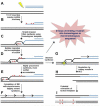Error-Prone Repair of DNA Double-Strand Breaks
- PMID: 26033759
- PMCID: PMC4586358
- DOI: 10.1002/jcp.25053
Error-Prone Repair of DNA Double-Strand Breaks
Abstract
Preserving the integrity of the DNA double helix is crucial for the maintenance of genomic stability. Therefore, DNA double-strand breaks represent a serious threat to cells. In this review, we describe the two major strategies used to repair double strand breaks: non-homologous end joining and homologous recombination, emphasizing the mutagenic aspects of each. We focus on emerging evidence that homologous recombination, long thought to be an error-free repair process, can in fact be highly mutagenic, particularly in contexts requiring large amounts of DNA synthesis. Recent investigations have begun to illuminate the molecular mechanisms by which error-prone double-strand break repair can create major genomic changes, such as translocations and complex chromosome rearrangements. We highlight these studies and discuss proposed models that may explain some of the more extreme genetic changes observed in human cancers and congenital disorders.
© 2015 Wiley Periodicals, Inc.
Figures




References
-
- Boboila C, Alt FW, Schwer B. Classical and alternative end-joining pathways for repair of lymphocyte-specific and general DNA double-strand breaks. Adv Immunol. 2012;116:1–49. - PubMed
Publication types
MeSH terms
Substances
Grants and funding
LinkOut - more resources
Full Text Sources
Other Literature Sources

